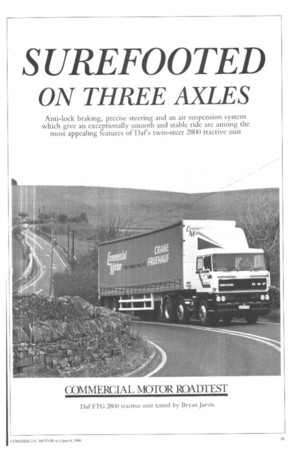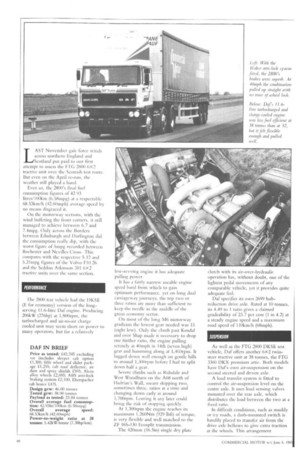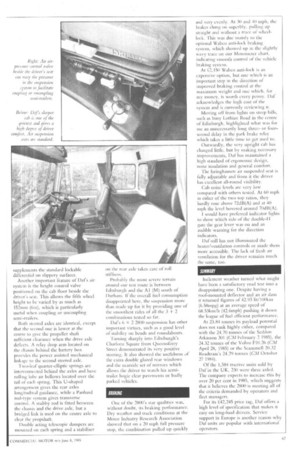SUREFOOTED
Page 67

Page 68

Page 69

If you've noticed an error in this article please click here to report it so we can fix it.
ON THREE AXLES
Anti-lock braking, precise steering and an air suspension system which give an exceptionally smooth and stable ride are among the most appealing features of Dal's twin-steer 2800 tractive unit
LAST November gale force winds across northern England and Scotland put paid to our first attempt to asscss the FTG 2800 6X2 tractive unit over the Scottish test route. But even on the April re-run, the weather still played a hand.
Even so, the 2800's final fuel consumption figures of 42.93 litres/100km (6.58mpg) at a respectable 68.53km/h (42.60mph) average speed by no means disgraced it.
On the motorway sections, with the wind buffeting the front corners, it still managed to achieve between 6,7 and 7.4mpg. Only across the Borders between Edinburgh and Darlington did the consumption really dip, with the worst figure of 5mpg recorded between Rochester and NeviIles Cross. This compares with the respective 5.12 and 5.21mpg figures of the Volvo F10.26 and the Seddon Atkinson 301 6x2 tractive units over the same section.
PERFORMANCE
The 2800 test vehicle had the DKSE (E for economy) version of the longserving 11.6-litre Dalengine. Producing 206kW (276hp) at 1,800rpm, the turbocharged and air-to-air charge cooled unit may seem short on power to many operators, but for a relatively
low-revving engine it has adequate pulling power.
It has a fairly narrow useable engine speed hand from which to gain optimum performance, yet on long dual carriageway journeys, the top two or three ratios arc more than sufficient to keep the needle in the middle of the green economy sector.
On most of the long M6 motorway gradients the lowest gear needed was 15 (eight low). Only the climb past Kendal and over Shap made it necessary to drop one further ratio, the engine pulling serenely at 40mph in 14th (seven high) gear and humming along at 1,400rpm. It lugged down well enough on gentle hills to around 1,300rpm before I had to split down half a gear.
Severe climbs such as Ridsdale and West Woodburn on the A68 north of Hadrian's Wall, meant skipping two, sometimes three, ratios at a time and changing down early at around 1,700rpm. Leaving it any later could bring the risk of stopping quickly.
At 1,300rpm the engine reaches its maximum 1,260Nm (929 lbft) of torque, is very flexible and well matched to the ZF 16S-130 Ecosplit transmission.
The 420mrn (16.5in) single dry plate clutch with its air-over-hydraulic operation has, without doubt, one of the lightest pedal movements of any comparable vehicle, yet it provides quite adequate feel.
Daf specifies its own 2699 hubreduction drive axle. Rated at 10 tonnes, its 4.49 to 1 ratio gives a claimed gradeability of 23.7 per cent (1 in 4.2) at a steady engine speed arid a maximum road speed of 110km/h (68mph).
SUSPENSION
As well as the FTG 2800 DKSE tel vehicle, Daf offers another 6X2 twinsteer tractive unit at 38 tonnes, the FTG 3300 DKX premium artic. Both models have Daf s own air-suspension on the second steered and driven axle.
A load transfer system is fitted to control the air-suspension level on the centre axle. It uses load sensing valves mounted over the rear axle, which distributes the load between the two at a fixed ratio.
In difficult conditions, such as muddy or icy roads, a dash-mounted switch is handily placed to transfer air from the drive axle bellows to give extra traction at the wheels. This arrangement supplements the standard lockable differential on slippery surfaces.
Another important feature of Daf's air system is the height control valve positioned on the cab floor beside the driver's seat. This allows the fifth wheel height to be varied by as much as 152mm (6th), which is particularly useful when coupling or uncoupling semi-trailers.
Both steered axles arc identical, except that the second one is lower at the centre to give the propeller shaft sufficient clearance when the drive axle deflects. A relay drop arm located on the chassis behind the battery box provides the power assisted mechanical linkage to the second steered axle.
Two-leaf quarter-elliptic springs are interconnected behind the axles and have rolling lobe air bellows located over the tail of each spring. This U-shaped arrangement gives the rear axles longitudinal guidance, while a Panhard rod-type system gives transverse control. A stubby rod is fitted between the chassis and the drive axle, but a bridged link is used on the centre axle to
clear the propshaft.
Double acting telescopic dampers are mounted on each spring and a stabiliser on the rear axle takes care of roll stiffness.
Probably the most severe terrain around our test route is between Edinburgh and the Al (M) south of Durham. If the overall fuel consumption disappointed here, the suspension more than made up for it by providing one of the smoothest rides of all the 3 + 2 combinations tested so tar.
Dal's 6 x 2 2800 suspension has other important virtues, such as a good level of stability on bends and roundabouts.
Turning sharply into Edinburgh's Charlotte Square from Queensferry Street demonstrated its very positive steering. It also showed the usefulness of the extra double glazed rear windows and the nearside set of mirrors which allows the driver to watch his semitrailer bogie clear pavements or badly parked vehicles.
BRAKING One of the 2800's star qualities was, without doubt, its braking performance. Dry weather and track conditions at the Motor Industry Research Association showed that on a 20 mph full pressure stop, the combination pulled up quickly and very evenly. At 30 and 40 mph, the brakes clung on superbly, pulling up straight and without a trace of wheellock. This was due mainly to the optional Wabco anti-lock braking system, which showed up in the slightly wavy trace on our Motometer chart, indicating smooth control of the vehicle braking system.
At 1:2,150 Wabco anti-lock is an expensive option, but one which is an important step in the direction of improved braking control at the maximum weight and one which, for my money, is worth every penny. Daf acknowledges the high cost of the system and is currently reviewing it.
Moving off from lights on steep hills, such as busy Lothian Road in the centre of Edinburgh, highlighted what was for me an unnecessarily long threeor foursecond delay in the park brake relay which takes a little time to get used to.
Outwardly, the very upright cab has changed little, but by making necessary improvements, Daf has maintained a high standard of ergonomic design, noise insulation and general comfort.
The Isringhausen air suspended seat is fully adjustable and from it the driver has excellent all-round visibility.
Cab noise levels are very low compared with others tested. At 60 mph in either of the two top ratios, they hardly rose above 72dB(A) and at 40 mph the level hovered around 70d B(A).
1 would have preferred indicator lights to show which side of the double-H gate the gear lever was on and an audible warning for the direction indicators.
Daf still has not illuminated the heater/ventilation controls or made them more accessible. The lack of fresh air ventilation for the driver remains much the same, too.
SUMMARY Inclement weather turned what might have been a satisfactory road test into a disappointing one. Despite having a roof-mounted deflector and an air dam it returned figures of 42.93 lit/1(X)km (6.58inpg) at an average speed of 68.53km/h (42.6mph) pushing it down the league of fuel efficient performance.
At 23.84 tonnes its payload potential does not rank highly either, compared with the 24.70 tonnes of the Seddon Atkinson 301 (CM February 2 1985), the 24.32 tonnes of the Volvo F10.26 (CM April 28, 1985) or the Scammell 20.32 Roadtrain's 24.29 tonnes (CM October 27 1984).
Of the 1,584 tractive units sold by Daf in the UK, 230 were three axled. The company expects to increase this by over 20 per cent in '1985, which suggests that it believes the 2800'is meeting all of the criteria demanded by operators and fleet managers.
For its .C42,245 price tag, Dal offers a high level of specification that makes it easy on long-haul drivers. Service support in Europe is another reason why Daf units are popular with international operators.




































































































